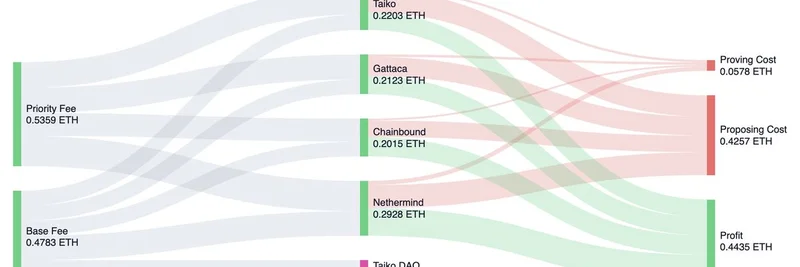Hey there, crypto enthusiasts! If you're into blockchain tech, especially the buzzing world of Ethereum rollups, you've got to check out this latest drop from Chainbound. They've just unveiled Taikoscope, a slick monitoring and analytics platform tailored for Taiko Alethia – that's the first "based rollup" on Ethereum. Let's break it down in simple terms and see why this is a game-changer.
What is Taikoscope?
Taikoscope is essentially a dashboard that keeps an eye on Taiko's network. It tracks things like how resilient the network is against issues, its overall security, and the flow of value – think fees and transactions moving through the system. Built by the team at Chainbound, who are all about optimizing blockchain infrastructure, this tool aims to provide real-time insights that benefit everyone from users to operators.
As you can see in the diagram above, it visualizes economic flows, like how base fees and priority fees get distributed among sequencers and cover costs, ultimately showing profits. Cool, right? This kind of transparency helps demystify what's happening under the hood.
Why Does It Matter for Based Rollups?
First off, what's a "based rollup"? In Ethereum lingo, a based rollup relies on Ethereum's own validators for sequencing – that's the process of ordering transactions – rather than having a separate set. Taiko Alethia is leading the pack here, but sequencers are whitelisted, meaning they're not fully decentralized yet. That partial trust factor makes independent monitoring crucial.
Taikoscope steps in to verify that operators are playing by the rules. It gives users, sequencers, and the Taiko team clear visibility into performance and potential risks. If something goes wonky – based on preset conditions – it automatically creates an incident on the Taiko status page. You can even subscribe for alerts to stay in the loop.
Chainbound highlighted this as "a major step toward proving data-driven insights on based rollups," emphasizing how it pushes the envelope for transparency in this space.
Diving Deeper: Features and Insights
Beyond just alerting on problems, Taikoscope digs into the economics of the network. It monitors gas usage, transaction costs, and sequencer performance metrics. This data isn't just for show – it helps optimize tools like Chainbound's Mk1 sequencer, which they open-sourced earlier this year. (Check out the details on their Mk1 announcement.)
There's even a leaderboard for economic performance, ranking sequencers based on efficiency and profitability. For blockchain practitioners, this means better decision-making and a healthier ecosystem overall.
Get Involved
Ready to explore? Head over to the Taikoscope dashboard for a hands-on look. And if you're a dev or just love tinkering, the entire codebase is open-source on GitHub at chainbound/taikoscope. Contributions are welcome – who knows, your input could shape the future of rollup monitoring!
For more in-depth reading, Chainbound's research post on launching Taikoscope has all the nitty-gritty details.
In a world where meme tokens and DeFi projects thrive on Ethereum's scalability, tools like Taikoscope ensure the underlying tech stays robust and transparent. Stay tuned for more updates, and let's keep building that knowledge base together!



